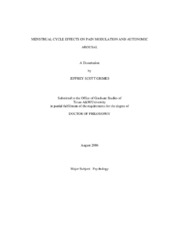| dc.description.abstract | Animal research has elucidated the neurobiological substrates and environmental
determinants of pain modulation. Despite these advances, relatively little is known
about how psychological processes activate pain modulatory systems. One
psychological process that is thought to play an important role in regulating pain
sensitivity is emotion. In addition, previous research into the human menstrual cycle and
the animal estrous cycle have determined that either the presence of certain gonadal
hormones or the fluctuations of these hormones may lead to changes in how females
perceive pain, regulate emotion, and modulate pain. The present study examines both
the role of emotion and the human menstrual cycle in pain modulation. Participants
were 39 female undergraduate students with a mean age of 18.7 years (SD=1.46).
Results are consistent with prior studies indicating that progesterone has antiinflammatory
effects. Specifically, significant effects were observed primarily in the
luteal phase. Subjects in the luteal phase demonstrated less sympathetic arousal during
the experiment but greater autonomic arousal during the noise stressor. Participants in
the luteal phase also demonstrated an analgesic/anti-inflammatory response evidenced by an observed decrease in secondary hyperalgesia for those that did not receive the
noise stressor. No such changes in pain perception were discovered in the ovulation
and follicular phases. Finally, in response to the noise stressor, an inhibition of the
analgesic/anti-inflammatory effects was observed in the luteal phase. No such
evidence of stress-induced pain modulation was discovered in the ovulation and
follicular phases. Although the specific mechanisms of this action still remain unclear,
prior evidence points to the role of centrally-mediated pain modulation. It is likely that
the stressor worked to inhibit the anti-inflammatory effects commonly observed in the
luteal phase to persistent inflammatory pain through centrally-mediated pain
modulatory mechanisms. It is hypothesized that hormone-mediated effects at the level
of the amygdala influenced the impact of affective pain modulation. | en |


